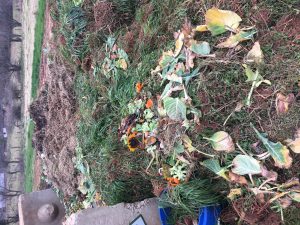For my outreach project, I, along with a few other of my classmates and professor Brickman, went to Clarke County High School to aid high school students in the completion and analysis of their soil bacteria project. At the high school, we aided in helping the students extract their results from the soil samples they collected and taught the how to enter their data into the data collection website. This was the same project that our class had just completed in the labs at the University of Georgia, so we were able to provide guidance to the students in finishing their similar project. The goal of the project was to enlighten us and the students of Clarke County High School on the presence of certain bacterias and their dominance in our neighboring environment, as well as their resistance to antibiotics.
During the project, we gathered with the students and helped them to analyze their petri dishes, which contained observable remains of bacteria that had been found in their soil extractions. After identifying them, we told to students to count all of the colonies of bacteria they observed in order to get a better picture of just how much bacteria lives in the environment around us. We then had them enter this data into a data collection site that is being used by researchers to identify different levels of bacteria around the world and their resistance to certain antibiotics. These results along with the ones we completed at UGA will help scientists better understand the bacteria around us and how it differs in various parts of the country.
Three Characteristics of Effective Informative Delivery:
- Intellectually Stimulating: Usually, we don’t think about all the bacteria that we encounter day-to-day, because we can’t see it. Thus, I think it was shocking but also very interesting for the students to be able to observe just how much bacteria we’re actually surrounded by. By placing the bacteria in a petri dish and allowing it to grow, we were actually able to see this and recognize the large amount of bacteria that usually goes unnoticed by us.
- Relevant to the audience: Everyone uses medicines like antibiotics throughout their life, making this a relevant study for anyone to conduct. It was interesting to find out that medicines I use for things like an ear infection could actually have negative consequences for my body such as increasing the number of antibiotic resistant bacteria.
- Creative: A creative aspect to this project was actually allowing the students to go out and bring back their own soil sample collection. This provided the study with different soil types from various places, so it was interesting to see how the bacteria differed from one sample to the next.
Discoveries
- I found out that I actually really liked helping the younger high school students with their projects. I could definitely see myself doing something like that again in the future for maybe tutoring or something along those lines.
- On the other hand, I also realized how difficult it was to get the high-schoolers interested and engaged in what we were doing for them.
I think that in the future I would need to do something to make the work seem more interesting and engaging, because it seemed like the students got bored rather fast with what we were doing. I also think that some students were a little shy and this caused them to participate less, so next time I would work on bringing those students out of their comfort zone in order to get them more engaged.
By helping the high school students with their project, I was better able to understand the study myself, which makes sense since I had to understand it in order to explain it to them. It was also helpful doing the project a second-time. I understood the process a lot better and why we were doing it the second-time. Next time I do a project like this I think it would be helpful for me to go over the process multiple times like we did here.
I think that I could have been more informed. There were some parts of the project and the data process that even I was still confused about when we were helping the high-school students, so that probably didn’t look good from their perspective. But, all-in-all I think I did a pretty good job in aiding them.
I learned alot from this project, so I would say it was very effective. I never realized how much bacteria surrounded me in my environment and how so much of it was resistant to bacteria. It was very enlightening, and it was refreshing actually doing something in a class and then relating it to real-world problems.



